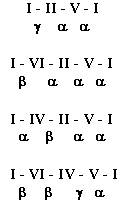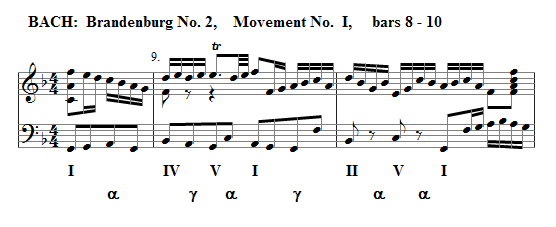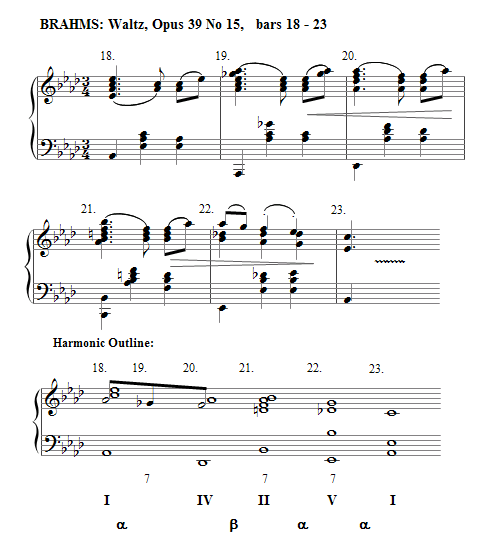
CHAPTER 2 (PART 2)
STATIC AND DYNAMIC HARMONY
Dynamic Harmony
The function of dynamic harmony is to provide a sense of moving forward, the change of status between static and dynamic harmony is critical in creating variety, enabling the ear to follow the phrase syntax and in creating musical form. Rather than an oscillation between chords, dynamic harmony in tonal music is made up of a succession of strong chord progressions. As roots of chords can exist on seven possible scale steps: I, II, III, IV, V, VI, VII each individual root has 6 possible roots to move to (ignoring octaves and chromatic notes). Consequently, roots may rise or fall a 2nd, rise or fall a 3rd, rise or fall a 4th.
Dynamic harmony in tonal music is made up almost exclusively of three of the six possible types of root progression. These will be referred to as the three strong chord progressions and will be labeled: alpha, beta and gamma (α, β and γ) progressions, as follows:
α - root progression by rising 4th (or falling 5th)
( e.g. V - I, I - IV etc.)
β - root progression by falling 3rd (or rising 6th)
( e.g. I - VI, VI - IV etc. )
γ - root progression by rising 2nd (or falling 7th)
(e.g. I - II, IV - V etc. )
The reversals of these progressions: α', β' and γ' are weak and are generally (but not completely) avoided in dynamic harmony in common practice tonal music.
It will be observed that this classification groups together root progressions which do not involve exactly similar intervals. For instance, the root progression β could involve a descent of a major or minor third depending on which chords are involved and whether the tonality is major or minor. In practice, both major and minor descending third progressions are frequent whereas both major and minor ascending third progressions are infrequent so that this classification adequately describes the use of root progressions. This is because the use of root progressions is primarily a diatonic and not a chromatic phenomenon. Chromatic harmony serves primarily to decorate rather than create structure.
The α chord progression is by far the strongest and most frequently used progression in dynamic harmony and when used to make the move from V to I at the end of a phrase it forms the perfect cadence. Of the other two progressions, the β progression is generally more common than the γ progression, in most compositions, but the relative frequency varies according to style and period of the music.
Whilst the primary triads IV and V are the most common chords used in forming static patterns, in one key, there is only one dynamic pattern that can be formed (starting and ending in chord I) with these chords, using only strong progressions, as follows:
![]()
Consequently, the secondary triads are used to extend the range of possible dynamic patterns. Chords II and VI are most useful for this purpose. Following are some common (non-modulating) patterns, starting and ending on the tonic:

The following example clearly shows the use of α and γ chord progressions. Even though the texture of the music is contrapuntal, and the writing is in two parts, the dynamic harmony is nevertheless clear. It should be noted that in the baroque and classical periods, α and γ progressions are often used in preference to other progressions.

Inversions weaken the feeling of moving forward. The chord progressions which have the strongest sense of moving forward tend to be those where the chords are all presented in root position and composers use the strongest chord progressions at the position in the structure where the strongest sense of movement is required.
This polarisation of chord progressions appears to have taken place gradually from around 1600 to around 1700 and is easily seen in the music of Bach and his contemporaries. Static and Dynamic harmony patterns, however, can be seen in music before that period but not with the same degree of polarisation.
Techniques for strengthening progressions can be seen in the following example from Brahms:

This example deploys α and β progressions. The chords in bars 19, 21 and 22 are all dominant 7th chords since they all take on an added 7th and, in case of bar 21, the minor third is raised to form a major third. Clearly all of these dominant 7ths chords do not indicate rapid modulations to new key centres. New key centres have to be established by the presence of static harmony or a cadence in the new key. The function here is just to strengthen the harmonic movement and to add variety and interest to the harmony. No modulation is intended or heard. Bars 107 to 114 of Brandenburg Concerto No 2. could be examined at this point. Here a whole series of seven dominant 7th chords (using six α and two β progressions) are used to form a very strong chord progressions prior to the final recapitulation of the main theme. They are preceded by a tonic chord and end with a tonic chord and therefore no modulation occurs in this example. This very strong sequence is used to alert the user to the imminent end of the movement. This Final Dynamic Episode thus has a formal or structural function as well as its normal syntactic phrase function.
The harmonic outline uses the symbols to be used in the rest of this book and in the Full Analysis Chapter. The white note heads represent structural notes in structural chords and black note heads are used to represent voice leading patterns. For instance, a 7th is added to the tonic chord in bar 19 as a passing note between the Ab of the tonic chord and the F of the subdominant chord in bar 20. The passing movement is highlighted here by the notes being connected by stems and a beam for clarity. Other 7ths additions to chords are shown as black note heads.
The examples given above are both from pieces in major keys. In the minor key, chords I and IV are minor, chord II is diminished and chord VI is major. However, these chords are used in a similar way to the way the same chords are used in the major key. I will include more on this topic in the full book.
Whereas in the baroque and classical periods, alpha and gamma progressions are often used in preference to other progressions, in the 19th century, beta progressions are often used in preference to gamma progressions.
In music prior to the tonal period and in 20th century modal music, the degree of polarisation is less evident so that the weaker progressions are used more frequently. Consequently, weak progression create a modal effect or mood. The degree of polarisation is thus a style indicator.
Even in one period of music the difference in frequency of use of progressions can be observed in different types of music. For instance, in the Bach Chorale harmonisations, the degree of polarisation is less than in the Brandenburg Concertos. This is because Bach is looking back to an earlier style in the chorales. This is a fact overlooked in some studies of root progressions.
Thus the choice of root progressions is an indicator of the period, style and mood of the music. I will include more on polarisation of progressions in the full thesis currently being written.
The reader is referred to Demo 2 which animates a succession of seven α progressions starting and ending in the tonic chord.

